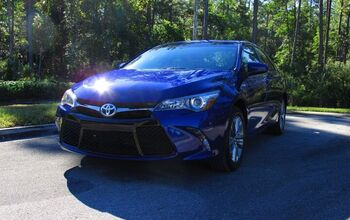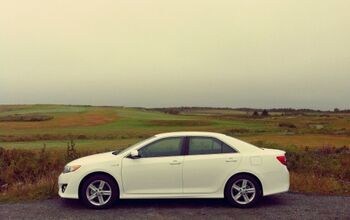Capsule Review: 2015 Toyota Camry XSE
The Camry connoisseur, if there is such a thing, would spot the difference.
Unlike some well-known TTAC authors who don’t hide their Camry admiration, I wasn’t on board the Camry love boat. The last SE I drove disappointed me with unimpressive efficiency figures, an interior in need of polish, and an overall sensation of obsolescence. And it was in fact obsolete, as Toyota Canada delivered a Camry Hybrid SE to my driveway in October 2014 when the refreshed 2015 car was already a thing.
• USD Base Price: $27,725
• Horsepower: 268 @ 6200 rpm
• Torque: 248 lb-ft @ 4700 rpm
• Observed Fuel Economy: 19.3 mpg
Nevertheless, I’ll readily admit I appreciate that Toyota finally located the Camry’s sense of style. When this particular car pulled up in front of our house, I noticed right off the bat that it was an XSE, a trim level Toyota introduced for 2015 to combine XLE luxury with the SE’s sporting intentions. The Blue Crush Metallic also represents top-notch taste.
While it’s my job and I do my best and I take a measure of pride in these things, I didn’t notice key signifiers: twin tailpipes. Granted, Blue Crush arrived on Monday, January 5, the busiest work day of the year for a sales-oriented auto writer like myself. I backed the car into our driveway, refusing to take time out of my busy schedule for an unnecessary late night Volkswagen GTI-like drive to the grocery store. “It’s not like it has a V6,” I muttered.
Yet there may be no V6 more captivating than a surprise V6 in an increasingly competent midsize sedan. You see, 24 hours after my muttering, I was heading into town to collect dog food. After a few miles of routine driving behind slow-moving traffic, I hit the highway under heavy throttle to see if Toyota further isolated the 178-horsepower, 2.5L four-cylinder’s inherent vibration. Except I couldn’t answer that question, because I was approaching my exit with more than enough pace to mutter, “This feels like an engine Lotus would squeeze into an Evora.”
Yes, Camry fanbois (if there are such a thing) would have understood the meaning behind Blue Crush’s dual exhaust outlets. But even in XSE trim, Toyota completely bypasses the V6 badging process. It’s debadged. Or at least unbadged.
Toyota is therefore cool, like the guy who ordered his Porsche 911 without all the extra taxonomical addenda. Or at least sort of like that guy.
Toyota says the 3.5L generates 268 horsepower and 248 lb-ft. It’s such a rev-hungry, buttery engine, however, that it feels like there are 300-plus of each. 0-60 mph times below six seconds bring believability to such feelings. The 6-speed automatic lacks all manner of aggression and rewards paddle shift inputs not at all, but it’s a sufficiently cooperative partner for the V6, never flubbing a shift or causing the driver to worry over fragility.
Blue Crush was much more than just an engine. Indeed, the XSE can be had for thousands less without the V6 powerplant. As a whole, the Camry is a stronger package now than it was last year. With “unique shock absorbers, firmer bushings, higher-rate coil springs, specially-tuned steering,” the XSE bears that out more clearly. The structure is stiffer, enabling Toyota to more finely tune the suspension for a very pleasing real-world balance. The ride is only just on the firm side of average, yet the Camry XSE handles ham-fisted, mid-corner adjustments easily and without fuss. The steering is still too slow and light for the XSE to be a genuine sports sedan; brake feel (said to be improved) and brake performance are not confidence-inspiring. But if this suspension configuration represented the conventional Camry’s layout, I believe enthusiasts would grow very fond of the midsize Toyota, and they would wonder just how good TRD’s engineering team could make it if given free rein.
The Mazda 6 is a sharper corner carver, but it rides more stiffly and is noisier inside. Dynamically, the Ford Fusion is very nicely balanced, but not every buyer will put up with Ford’s current infotainment unit when the Camry’s system is so straightforward and intuitive. Hyundai and Kia, with the Sonata and Optima, aren’t yet able to mate serene ride quality to their more aggressive suspension tunes. For a moment, it seemed as though Nissan built the better Camry with their fifth-gen Altima, but the 2015 Camry refresh is a significant one.
Not surprisingly then, the Blue Crush’s prime competition comes in the form of America’s second-best-selling car, the Honda Accord. It’s a game of personal preference at that point.
Personally, I’m pleased to discover a Camry that appeals on a large number of different levels. It’s still not the most handsome sedan, its interior is completely devoid of expression, it will quickly become terribly commonplace, it drank at a sub-20-mpg rate during its stay with me. But the Camry XSE is the place where solidity, reliability, and space marry moderate degrees of fun, modestly increased levels of vehicular passion, and mature amounts of back road frolicking.
And it’s relatively affordable. In the United States, Camry XSEs start at $27,725. That’s $2310 more than the SE and the same price as the XLE.
Adding the V6 to a 2015 Toyota Camry XSE costs another $5220, but the V6 XSE includes a raft of equipment that’s optional on the four-cylinder model. It’s worth it. If you’re going to buy America’s best-selling car in large part because the sampling size which helped establish its image of dependability is so large, you owe it to yourself to get the best version of America’s best-selling car.
Timothy Cain is the founder of GoodCarBadCar.net, which obsesses over the free and frequent publication of U.S. and Canadian auto sales figures.
More by Timothy Cain
Latest Car Reviews
Read moreLatest Product Reviews
Read moreRecent Comments
- Chelsea I actually used to work for this guy
- SaulTigh Saw my first Cybertruck last weekend. Looked like a kit car...not an even panel to be seen.
- GregLocock Bear in mind this is purely a branding exercise and has no significant input from AM. Buying one of these is like buying a Pink Floyd T shirt, no Dave and Nick didn't personally sew it up for you.
- Lou_BC This is the sort of thing that lands 15 billion dollar Honda investments in Canada. One political party tries to undo everything the other one has done.
- Ajla "Mr Musk needs to go" "should not be CEO anymore."It isn't exactly easy getting rid of someone that owns 20.5% of the company (likely 25% by year's end), is one of the wealthiest people on Earth and has a giant media presence. Elon's only stepping down if he or God makes the decision.




































Comments
Join the conversation
The crossing guard for the elementary school down my street just bought a ruby red 2015 Camry to replace her 1995 Chevy Lumina,also red, which she bought new in 1995 and had been driving every day with, in her words, "zero problems." I'd say it's great for someone like her. It's got all the right styling cues, like the rubber triangle reminiscent of the Ford LTD behind the rear windows, but clearly much sportier! Clearly...
For the price tag I'd rather have a Charger V6 SXT. I realize its a full-size, not a mid-size, BUT it is RWD. That leads to superior driving dynamics without sacrificing as much ride quality. The Pentastar V6 with the 8sp trans is a fantastic powertrain that balances economy and power quite well. Take that and combine it with the Dodge's U-connect infotainment and a higher quality interior and there's no contest IMO. As far as reliability goes I expect any car from any manufacturer* to serve as vehicle that will give me 100,000 reliable miles of service. Besides, these Chargers are beat to hell in police duty and they seem to take it in stride. *Exception: Land Rover and Jaguar products